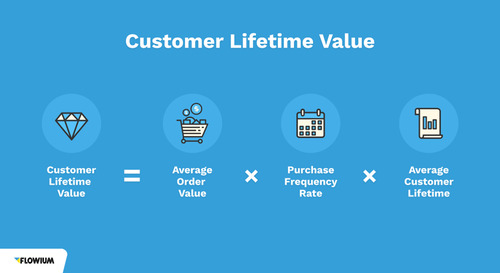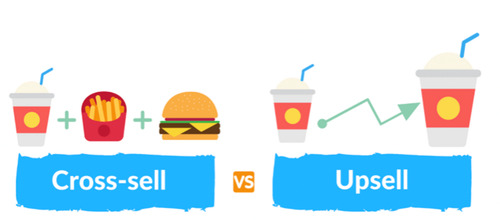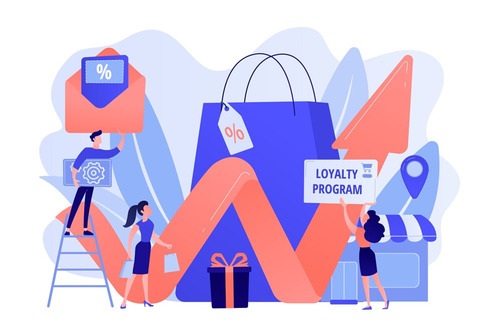Welcome to our guide all about selling more stuff and keeping customers happy on your online store! We’re going to talk about two important things: upselling and cross-selling.
These are fancy terms, but don’t worry, we’ll break them down so they’re easy to understand. Basically, upselling means getting customers to buy more expensive stuff, while cross-selling means suggesting related products.
Understanding these concepts and how they can boost your sales is super important for any online business, especially if you’re using WooCommerce.
We’ll also dive into why customers stick around and spend more money over time, which is called Customer Lifetime Value (CLV).
So, get ready to learn some cool strategies to make more money and keep your customers coming back for more!
What is Upsell?
DID YOU KNOW?
“About 35% of Amazon’s revenue is generated by its upselling and cross-selling strategies according to Predictable Profits.”
Upselling is a sales technique where the seller encourages a customer to purchase a more expensive item, upgrade a product, or add on extra features to make a more profitable sale.
The goal is to increase the value of the current sale and consequently, increase the business’s revenue. Effective upselling techniques can help a business increase its average value or customer lifetime value, generating more revenue immediately or over the long term.
Understanding Customer Lifetime Value (CLV)
Customer Lifetime Value (CLV) is an important metric that holds the key to sustainable success in eCommerce. It shows the total revenue a business can expect from a single customer through their entire relationship with the company.
Understanding CLV goes beyond simply knowing the immediate value of a transaction; it dives into the long-term profitability and loyalty of each customer.
Importance of CLV in eCommerce
CLV is a way to figure out how much each customer is worth to your business in the long run. Clv is not just about one sale; it’s about seeing the future potential of your business, about future sales, upgrades, and referrals that customers might bring.

[Source: Flowium]
In eCommerce, where getting new customers can be tough, CLV helps you understand the value of keeping the ones you already have. By knowing how much each customer is worth, you can focus on keeping them happy and coming back for more.
Difference Between Upselling and Cross-Selling
While Upselling and Cross-selling are both sales techniques that increase revenue, they do so in slightly different ways.

[Source: Involve]
While upselling convinces a customer to purchase a more expensive version of a product or service, cross-selling encourages them to add related or complementary items to their existing purchase.
The Psychology Behind Upselling
The psychology behind upselling is to understand consumers’ behavior and build trust and loyalty. Effective Upselling and Cross-Selling tap into customers’ desires for value and improved experiences.
By matching your recommendations with customer’s preferences and needs, businesses can create a more personalized and appealing offer, which creates a sense of understanding and connection.
What is the Power of Upselling & Why Upselling Works?
Upselling is when a business suggests you buy something extra or fancier than what you originally planned to get. It works because of how our brains work. When we’re offered something with more benefits or features, it seems like a better deal, even if it costs a bit more.
Also, when something seems limited or only available for a short time, we feel like we need to grab it quickly, which makes us more likely to say yes. Seeing other people choose the same upgrade also makes us feel more comfortable about our decision.
And when we’re given a higher price first, the normal price doesn’t seem so bad, so we’re more likely to go for the upgrade. So, businesses use these tricks because they know they make us more likely to spend extra money.
Now let’s see some of the best strategies that can be helpful to increase customers’ lifetime value
How To Upsell? Best Strategies to Maximize Customer Lifetime Value
Let’s see some of the strategies to maximize your Customer’s Lifetime Value
- Personalized Recommendations
Personalization is the key to enhancing the customer shopping experience. Utilize sophisticated techniques and analyze customers’ data and behavior by integration tools like Google Analytics and Heatmap Systems.
Based on these data past purchases, demographics, and preferences.
You can understand each customer’s unique preferences, and you can provide them with product recommendations that are most likely to resonate with them.
- Product Bundles
Bundling related products together not only increases the perceived value of customers but also encourages them to purchase additional products, because when you bundle 2 products you give additional discounts this makes them think that they are getting more value with less investment.
Make sure to create bundles that combine well, and offer them at a discounted price compared to purchasing them separately.
Highlight the savings and benefits that customers can enjoy by opting for the product bundle. WooCommerce has built-in functionality to create products, and there are also third-party plugins available to simplify the process.
- Email Marketing
Email remains one of the most effective channels for driving more sales and nurturing customer relationships. Segment your email list based on their past purchases and behavior and send targeted recommendation emails.
For instance, send specific product recommendations to customers who have recently purchased a specific category of product.
Use engaging subject lines and compelling visuals like short and informative infographics to capture customer’s attention.
- Offer Discounts
Discounts and promotions can be powerful strategies to encourage customers to add more items to their carts.
For example, offering a high discount on a second item when customers purchase a specific product or spend a certain amount. You can also implement tiered discounts where the discount increases with the number of items purchased.
There are a lot of WooCommerce plugins out there that can help you set up and manage various discount strategies.
- Create Cross-Sell Funnel
Create cross-sell funnels that guide the customer through a series of related products and gradually increase the value of their purchase. Start by recommending lower-priced items and gradually upsell to higher-priced and complementary products.
For example, if a customer adds a camera to their cart, you can cross-sell camera-related accessories such as lenses, tripods, and camera bags.
WooCommerce Plugins like One Click Upsell Funnel allow you to set up upsell and cross-sell funnels with ease easily.
- Post-Purchase Upselling
The post-purchase phase presents another opportunity to upsell or cross-sell to customers. After a successful purchase, redirect your customers to a thank you page that includes relevant product recommendations or offers. You can also include upsell offers in the order confirmation email sent to customers.
Make sure to highlight the recommended benefits, give additional discounts, and provide a simple way for customers to add them to their cart.
- Loyalty Program
Loyalty programs encourage customers to make repeated purchases by rewarding them for their loyalty. Offer points for every purchase made, which customers can use and redeem for discounts or for free products. Encourage your customers to enroll in your loyalty program by offering bonus points for signing up and promotional activities.

Leverage WooCommerce Plugins like Points and Rewards for WooCommerce which allows you to implement a customizable loyalty program tailored to your unique business needs.
- Optimize Your Product Pages
Product pages play a crucial role in driving upsells and cross-sells. Optimize your product pages by showcasing related or complementary products that complement the item being viewed. Use high-quality images, detailed product descriptions, and persuasive call-to buttons to encourage them to explore additional products.
If they explore from here and purchase a product then eventually you don’t need to show them the upselling offers.
- Monitor and Analyze Results
Continuously Monitor the performance of your upselling and cross-selling strategies to identify what works and what doesn’t. Track key performance indicators such as average order value, conversion rate, revenue generated from upsell and cross-sell, and customer retention rates.
Use A/B testing to experiment with different strategies and optimize your approach over time. WooCommerce has some in-built analytics tools but you can also integrate third-party analytics platforms like Google Analytics for more in-depth insights.
Common Mistakes That Can Make Customers Leave
Let’s see some common mistakes that you should avoid that can scare your customers off…
- Overwhelming Them With Too Many Choices
While Presenting customers with additional products or potential upgrades can be beneficial, bombarding them with too many options can overwhelm and confuse them. Avoid presenting a lot of upselling product suggestions that may distract or intimidate customers.
Instead, focus on offering a select few options that are genuinely relevant to and valuable for them.
- Aggressive Sales Tactics
Pushy or aggressive sales tactics can quickly frustrate customers and tarnish your brand reputation. Your upselling strategy should always feel like a helpful recommendation rather than a forceful sales pitch.
Avoid pressuring customers into making additional purchases or using manipulative language that lowers their trust. Instead, approach upselling with a customer-centered mindset, prioritizing their needs and preferences.
- Ignoring Customer Preferences and History
Neglecting to consider a customer’s preferences, past purchases, and browsing history is a huge opportunity you’ll miss while upselling.
As I have already mentioned, personalization is the key to effective upselling, as it demonstrates that you understand and value the relationship between you and your customers.
Failing to customize your upsell offer to individuals’ preferences can lead to irrelevant recommendations that can frustrate your customers rather than add value.
- Wrong Timing
Timing is one of the most important things in any eCommerce operation.
It’s very crucial in upselling, and presenting additional offers at the wrong moment can disrupt the customer’s shopping experience. Avoid interrupting the checkout process with last-minute upsell offers that may feel intrusive or distracting.
Instead, you can integrate upselling throughout the customer journey, from product discovery to post-purchase follow-up and make sure that offers are presented at appropriate touchpoints.
- Failing to Provide Opt-out Options
While Upselling can be very effective when done right, not all customers will be looking for additional offers. Failing to provide an exit option or making it difficult for customers to decline upselling suggestions can lead to frustration and dissatisfaction and can decrease your customer’s loyalty.
Respect your customer’s choice by offering them a clear exit option so they can easily close the offer if they don’t want to purchase any additional products.
- Not Showing the Value Proposition
Simply presenting additional products without clearly communicating their value proposition is a missed opportunity in upselling.
Your customers will only purchase any additional products if they believe that they are getting huge value from them. Customers need to understand why the upsell offer is beneficial to them and how it enhances their purchase experience.
Don’t just assume that the customer will automatically recognize the value of the upsell suggestion. Instead clearly inform them of the benefits and advantages of each offer, focusing on how it addresses their specific needs or desires.
Wrapping UP!
Alrighty, that’s a wrap! We’ve covered a lot of ground on how to make more sales and keep your customers happy. Remember, the key is to understand what your customers like and suggest things they’ll actually want to buy. By doing this, you can make more money and build strong relationships with your customers.
So, keep on learning, keep on trying new things, and most importantly, keep on making your customers smile.
Here’s to your success in boosting sales and making your online store the best it can be!

